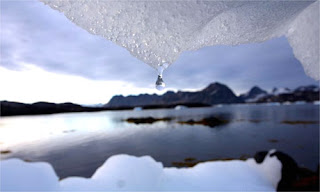El documento que se extiende por 36 páginas sintetizó más de 1.400 estudios presentados en la conferencia sobre el clima celebrada en marzo en Copenhague; mismo lugar que en diciembre espera recibir a las Naciones Unidas para negociar en dicha reunión un acuerdo que tome el relevo del (próximo a expirar en e 2012), Protocolo de Kyoto.
A seis meses de la conferencia de Copenhague, este informe habla de las previsiones de los expertos en cuanto por ejemplo a: los acontecimientos climáticos extremos; el nivel del mar; el deshielo en el Ártico; la superficie global y la temperatura de los océanos han quedado escasas, y estos se están incrementando significativamente más rápido de lo previsto un par de años atrás, expusieron.
Se plantea entonces en la exposición, que las emisiones de gases con efecto invernadero y otros indicadores climáticos están en o cerca de los límites previstos por el Panel Intergubernamental de la ONU sobre el Cambio Climático (IPCC – informe del 2007), y que la actividad humana es directa parte responsable en contribuir al calentamiento global.
Ahora no solo estamos ante nuestras acciones directas contra el medio, sino contra las consecuencias mismas de nuestras acciones pasadas; grandiosas cantidades de entre otros, el fuerte gas de efecto invernadero, metano, atrapadas durante milenios en la capa subterránea de hielo del Ártico estarían a punto de ser liberadas a la atmosfera, acelerando significativamente el proceso de calentamiento global.
Tambien se encontraría en peligro la capacidad de los oceanos y bosques de absorber naturalemente el CO2 originado por la quema de combustibles fósiles, según lo indica la investigación..
El nuevo informe fue escrito y revisado por muchos de los científicos que estuvierone n la tarea de recopilación del documento del IPCC; y su proposito es llamar a los politicos a dar pasos necesarios y urgentes:
“Una moderación rápida, sostenida y efectiva… es necesaria para evitar el peligroso cambio climático, sea como sea que está definido”; “Una subida de las temperaturas de más de 2 grados dificultará la vida de las sociedades futuras, y es probable que causen mayores trastornos medioambientales y sociales durante y a partir del próximo siglo”, se advirtieron.
Pero según el IPCC, las naciones industrializadas deberán reducir drástica y significativamente sus emisiones de gas de efecto invernadero; y los números propuestos y necesarios, están entre un 20 y un 45% en comparación con los niveles de 1990. De no ser así será difícil, tal vez imposible, revertir el proceso.
“Objetivos más débiles para 2020, incrementan el riesgo de impactos serios, incluyendo la superación de la barrera a partir de la cual las fuerzas naturales empiezan a empujar las temperaturas hacia arriba incluso más rápidamente”.
Los impactos del cambio climático podrían ser peores de lo previsto, y llegar aun más pronto que tarde; por su parte expertos en clima del Instituto Tecnológico de Massachusetts (MIT), hacen cálculos acerca de la cantidad de grados que la temperatura de la Tierra incrementará para el 2010 y en comparación con lo que se predijo por el 2003: ellos diagnostican que a pesar de los grandes esfuerzos que se han hecho para reducir drásticamente la contaminación, la temperatura de la superficie de la Tierra se incrementará más del doble previsto hacia el 2010, en un total de 5,2 grados.
El primer ministro danés, Lars Loekke Rasmussen, ha insitido a los científicos a dar “indicaciones concretas” a los políticos, cuando el informe sea presentado este jueves durante la Cumbre de la Unión Europea (UE) en Bruselas.
Artículos relacionados:
- Según estudio científico, aves migratorias se mueven cada vez más al norte
- Informe postula la irreversibilidad del cambio climático
- Informe advierte sobre la vulnerabilidad del Caribe Insular frente al cambio climático
- Informe de Greenpeace señala el vÃnculo entre ganaderÃa y deforestación en la Amazonia

 (vía NeoFronteras.com)
(vía NeoFronteras.com)











